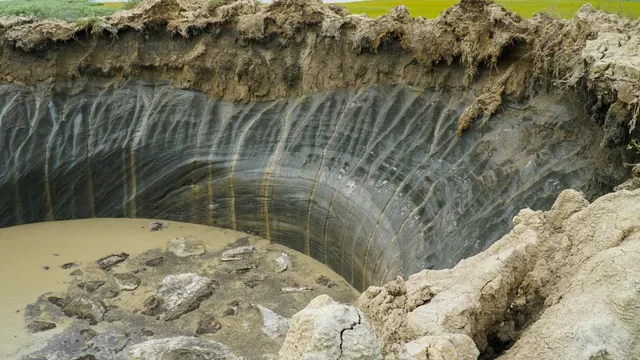
Batagaika Crater expands rapidly and endangers climate stability
2025-04-11 09:02- The Batagaika Crater in Siberia is rapidly expanding, with significant permafrost melting indicating severe climate change effects.
- It has exposed ancient remnants, including a baby mammoth, revealing insights into the planet's climate history.
- The ongoing research aims to understand these changes, but the accelerating pace of environmental shifts poses challenges for scientific monitoring.
Express your sentiment!
Insights
In Russia's Siberia, particularly near Batagay, the Batagaika Crater represents a dramatic environmental shift, originating as a minor depression in the 1960s and evolving into the Earth's largest thermokarst depression. Currently, it is 1 kilometer long and up to 100 meters deep, showcasing the rapid melting of ice-rich permafrost due to climate change. The crater has expanded significantly, growing by several meters annually and tripling in size over 30 years. The process involves a feedback loop where thawing leads to further erosion, exposing more permafrost and organic matter, which contributes to the release of greenhouse gases trapped in ice since ancient times. An alarming aspect of this geological phenomenon is how it has begun to unearth remnants from the past, including organic materials like plants, animals, and even entire bodies preserved for thousands of years. In 2024, the remarkably preserved body of a baby mammoth named Yana was discovered within the crater, providing scientists valuable insights into ecosystems from 50,000 years ago. This find underscores the urgency of understanding and documenting permafrost degradation as ancient microorganisms and bacteria are released, potentially affecting health, as seen in the 2016 anthrax outbreak linked to thawed reindeer remains. The implications of the crumbling permafrost extend deep into environmental science and climate forecasting. As Arctic regions experience profound changes, locations like Ny-Ålesund in Norway, the world’s northernmost settlement, house international scientific efforts to monitor these shifts. The knowledge gained from such research is crucial in understanding climate changes occurring now and into the future. However, with permafrost thawing, researchers face challenges such as limited access to sea ice for study, affecting data collection and long-term climate predictions. Efforts are being made by scientists to minimize their environmental impact while conducting research in sensitive areas. Collaboration among multiple countries’ research teams is vital to maintaining a low carbon footprint while attempting to gather high-quality environmental data. The Ny-Ålesund team prioritizes planning and execution strategies to prevent disturbances that impact sensitive measurements. As climate change accelerates, understanding the dynamics of thermokarst formations like the Batagaika Crater becomes increasingly essential for safeguarding our planet's future climate stability.
Contexts
Thawing permafrost is a critical factor in the discourse of climate change, as it represents both a symptom and a contributing driver of global warming. Permafrost, a layer of permanently frozen soil found predominantly in polar regions, stores vast amounts of organic carbon that have accumulated over thousands of years. As global temperatures rise, the thawing of permafrost accelerates, releasing carbon dioxide and methane, both potent greenhouse gases, into the atmosphere. This release enhances the greenhouse effect, further warming the planet and creating a feedback loop that compounds climate change. The scenarios predicted by climate models suggest that if substantial areas of permafrost continue to degrade, the impacts on global temperatures could be significant, potentially leading to temperature rises that exceed current projections. The implications of this phenomenon are far-reaching, affecting not only local ecosystems and wildlife in Arctic regions but also global weather patterns and sea-level rise. As permafrost thaws, the resulting changes in land stability can lead to increased incidences of landslides, infrastructural challenges, and alterations in the habitats of various species. Moreover, the release of these greenhouse gases as a result of thawing can disrupt the delicate balance of global carbon cycles, complicating efforts to mitigate climate change and posing a challenge to international climate agreements aimed at reducing emissions. In addition to environmental changes, the thawing of permafrost can have severe socio-economic consequences for indigenous communities and nations that rely on these ecosystems. These communities often face threats to their livelihoods due to changing landscapes, disrupted hunting and fishing practices, and challenges to traditional ways of life. The deterioration of infrastructure in permafrost regions also represents a potential economic burden, as buildings and roads constructed on this previously stable ground may become undependable and require significant investment to adapt or relocate. To address the ongoing threat of thawing permafrost, comprehensive research is essential. Understanding the rate at which permafrost is thawing and the specific regions most vulnerable to these changes is crucial for developing predictive models. Policymakers must consider these insights in climate action plans and prioritize funding for adaptive strategies. International cooperation will be paramount as nations confront the complexities of a changing climate exacerbated by thawing permafrost, as the ramifications extend beyond borders, impacting global climate stability and requiring collective efforts to reduce greenhouse gas emissions.